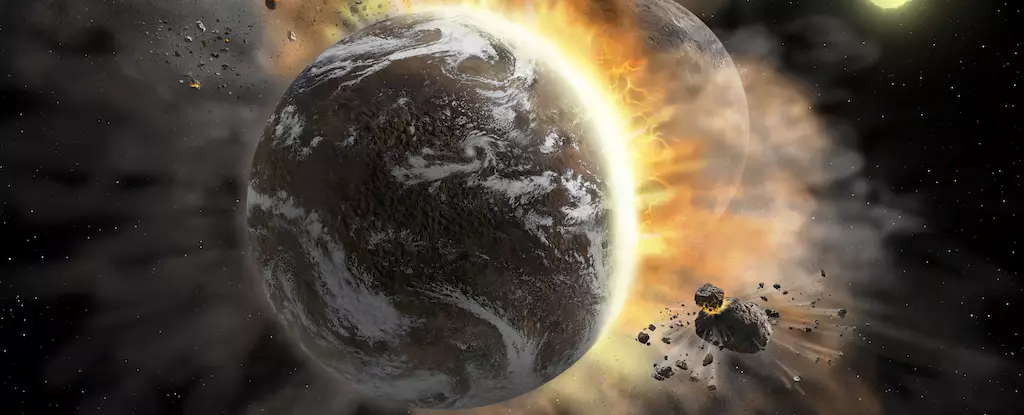When we think of the Solar System, images of serene planets in orderly orbits often come to mind. However, that picture is misleading when we peer back into its formative years. The Moon serves as a haunting reminder of this chaotic past, its surface riddled with craters that speak volumes of relentless collisions and impacts. What took place long ago, in a time characterized by tumult and disorder, is reflective of the early solar systems around distant stars. As researchers continue to delve into this celestial chaos, one particularly fascinating investigation seeks to simulate the cosmic ballet between massive planetary bodies.
Recent work has shifted our gaze toward understanding how colossal gas giants may have developed through a series of cataclysmic interactions with smaller protoplanets. Not only do such collisions create dramatic changes in mass and composition, but they also initiate tidal forces capable of triggering seismic waves within these massive formations. This line of inquiry not only sheds light on the characteristics of exoplanets but also inspires awe at the violent processes that sculpt celestial worlds.
Planetary Collisions and Their Seismic Aftermath
A groundbreaking study, led by theoretical physicist J.J. Zanazzi at UC Berkeley, dives into the specifics by simulating a collision between a younger gas giant and a larger, older one. This research, titled “Seismic Oscillations Excited by Giant Impacts in Directly-Imaged Giant Planets,” aims to address two core questions. Firstly, can such a collision generate substantial and lasting seismic waves? Secondly, is the James Webb Space Telescope (JWST) capable of detecting these seismic-induced changes?
While the JWST does not directly observe seismic waves, it excels at capturing minute fluctuations in light. If the seismic disturbances are pronounced enough, the telescope could detect the photometric variations in a gas giant’s luminosity. In this regard, the scientists posit that massive impacts on young gas giants could excite vibrations that reverberate throughout a planet, making them a potential target for observational programs utilizing next-generation space telescopes.
Beta Pictoris b: A Platform for Discovery
The researchers zeroed in on a particularly intriguing exoplanet—Beta Pictoris b, a super-Jupiter-type planet with a mass approaching that of 13 Jupiters and located roughly 12 to 20 million years from its formation. The Beta Pictoris system has captured the attention of astronomers, who speculate that this young gas giant possesses a surprising abundance of heavy metals, likely attributed to complex accretion processes during its formation. Estimated to contain between 100 and 300 Earth masses of elements heavier than hydrogen and helium, which scientists refer to as “metals,” Beta Pictoris b serves as an ideal laboratory for investigating the outcomes of planetary collisions.
The research theorizes that if a Neptune-like planet, with a mass of 17 Earth masses, collided with Beta Pictoris b, the seismic waves generated could provide long-lasting signatures observable by the JWST. The implications of such seismic activity are compelling: they might reveal vital characteristics about the planet’s internal structure and composition through detailed analysis of its light variations over time.
The Future of Seismology in Astronomy
Delving into the heart of exoplanets is no small feat. Gravity measurements have been utilized to explore the internal structures of gas giants, but the method proposed by Zanazzi and his colleagues stands to revolutionize our understanding of distant worlds. By employing seismological techniques, astronomers might unlock a wealth of information about planetary dynamics and migration patterns.
This seismic investigation extends beyond simply understanding Beta Pictoris b. The possibilities for detecting oscillations in other distant giant planets—particularly those experiencing hot or warm Jupiters’ high eccentricity migrations—could unlock a deeper understanding of formation processes across diverse exoplanetary systems.
The researchers posit that naturally evolving conditions—such as gravitational tidal forces from a parent star—could excite oscillations that would reveal insights into both the planet’s formation history and its current state. Telescopes like the JWST provide a unique opportunity to explore these phenomena, turning what was once theoretical into tangible scientific exploration.
With the prospect of digging deeper into the seismic signatures of gas giants, we stand on the precipice of a new era in planetary science. The study of seismic oscillations might not only illuminate the mysteries of Beta Pictoris b but could also chart unknown territories in our understanding of the celestial environment, emphasizing quality over quantity in the formation narrative of the cosmos. Thus, as we peer into the vastness beyond our own Solar System, we are reminded that every collision writes a new chapter in the unfolding story of planetary evolution.

